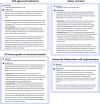Medical education with large language models in ophthalmology: custom instructions and enhanced retrieval capabilities
- PMID: 38719344
- PMCID: PMC11503072
- DOI: 10.1136/bjo-2023-325046
Medical education with large language models in ophthalmology: custom instructions and enhanced retrieval capabilities
Abstract
Foundation models are the next generation of artificial intelligence that has the potential to provide novel use cases for healthcare. Large language models (LLMs), a type of foundation model, are capable of language comprehension and the ability to generate human-like text. Researchers and developers have been tuning LLMs to optimise their performance in specific tasks, such as medical challenge problems. Until recently, tuning required technical programming expertise, but the release of custom generative pre-trained transformers (GPTs) by OpenAI has allowed users to tune their own GPTs with natural language. This has the potential to democratise access to high-quality bespoke LLMs globally. In this review, we provide an overview of LLMs, how they are tuned and how custom GPTs work. We provide three use cases of custom GPTs in ophthalmology to demonstrate the versatility and effectiveness of these tools. First, we present 'EyeTeacher', an educational aid that generates questions from clinical guidelines to facilitate learning. Second, we built 'EyeAssistant', a clinical support tool that is tuned with clinical guidelines to respond to various physician queries. Lastly, we design 'The GPT for GA', which offers clinicians a comprehensive summary of emerging management strategies for geographic atrophy by analysing peer-reviewed documents. The review underscores the significance of custom instructions and information retrieval in tuning GPTs for specific tasks in ophthalmology. We also discuss the evaluation of LLM responses and address critical aspects such as privacy and accountability in their clinical application. Finally, we discuss their potential in ophthalmic education and clinical practice.
Keywords: Medical Education.
© Author(s) (or their employer(s)) 2024. Re-use permitted under CC BY. Published by BMJ.
Conflict of interest statement
Competing interests: None declared.
Figures





Similar articles
-
A review of ophthalmology education in the era of generative artificial intelligence.Asia Pac J Ophthalmol (Phila). 2024 Jul-Aug;13(4):100089. doi: 10.1016/j.apjo.2024.100089. Epub 2024 Aug 10. Asia Pac J Ophthalmol (Phila). 2024. PMID: 39134176 Free PMC article. Review.
-
Large Language Models in Worldwide Medical Exams: Platform Development and Comprehensive Analysis.J Med Internet Res. 2024 Dec 27;26:e66114. doi: 10.2196/66114. J Med Internet Res. 2024. PMID: 39729356 Free PMC article.
-
Exploring the Potential of Code-Free Custom GPTs in Ophthalmology: An Early Analysis of GPT Store and User-Creator Guidance.Ophthalmol Ther. 2024 Oct;13(10):2697-2713. doi: 10.1007/s40123-024-01014-w. Epub 2024 Aug 14. Ophthalmol Ther. 2024. PMID: 39141071 Free PMC article.
-
EyeGPT for Patient Inquiries and Medical Education: Development and Validation of an Ophthalmology Large Language Model.J Med Internet Res. 2024 Dec 11;26:e60063. doi: 10.2196/60063. J Med Internet Res. 2024. PMID: 39661433 Free PMC article.
-
Understanding natural language: Potential application of large language models to ophthalmology.Asia Pac J Ophthalmol (Phila). 2024 Jul-Aug;13(4):100085. doi: 10.1016/j.apjo.2024.100085. Epub 2024 Jul 25. Asia Pac J Ophthalmol (Phila). 2024. PMID: 39059558 Review.
Cited by
-
New frontiers in generative artificial intelligence - enhancing custom GPTs with ophthalmology guidelines.Eye (Lond). 2025 May;39(7):1235-1237. doi: 10.1038/s41433-025-03746-w. Epub 2025 Mar 17. Eye (Lond). 2025. PMID: 40097744 No abstract available.
-
A review of ophthalmology education in the era of generative artificial intelligence.Asia Pac J Ophthalmol (Phila). 2024 Jul-Aug;13(4):100089. doi: 10.1016/j.apjo.2024.100089. Epub 2024 Aug 10. Asia Pac J Ophthalmol (Phila). 2024. PMID: 39134176 Free PMC article. Review.
-
Generative artificial intelligence in graduate medical education.Front Med (Lausanne). 2025 Jan 10;11:1525604. doi: 10.3389/fmed.2024.1525604. eCollection 2024. Front Med (Lausanne). 2025. PMID: 39867924 Free PMC article. Review.
-
Can ChatGPT-4o Really Pass Medical Science Exams? A Pragmatic Analysis Using Novel Questions.Med Sci Educ. 2025 Feb 4;35(2):721-729. doi: 10.1007/s40670-025-02293-z. eCollection 2025 Apr. Med Sci Educ. 2025. PMID: 40352979 Free PMC article.
-
Foundation models in ophthalmology: opportunities and challenges.Curr Opin Ophthalmol. 2025 Jan 1;36(1):90-98. doi: 10.1097/ICU.0000000000001091. Epub 2024 Nov 4. Curr Opin Ophthalmol. 2025. PMID: 39329204 Free PMC article. Review.
References
-
- Bommasani R, Hudson DA, Adeli E, et al. On the opportunities and risks of foundation models. http://arxiv.org/abs/2108.07258 n.d. Available.
-
- Brown TB, Mann B, Ryder N, et al. Language models are few-shot learners. 2020. https://proceedings.neurips.cc/paper/2020/file/1457c0d6bfcb4967418bfb8ac... Available.
-
- Nori H, Lee YT, Zhang S, et al. Can generalist foundation models outcompete special-purpose tuning? case study in medicine. 2023. http://arxiv.org/abs/2311.16452 Available.
Publication types
MeSH terms
LinkOut - more resources
Full Text Sources
